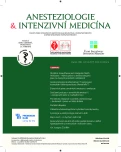Anaesthesia for CT-navigated irreversible electroporation (NanoKnifeTM)
Authors:
Málek Jiří 1; Šturma Jan 1; Janík Václav 2; Kurzová Alice 1
Authors‘ workplace:
Klinika anesteziologie a resuscitace 3. LF UK a FNKV Praha
1; Radiodiagnostická klinika 3. LF UK a FNKV Praha
2
Published in:
Anest. intenziv. Med., 24, 2013, č. 2, s. 84-90
Category:
Anaesthesiology - Original Paper
Overview
Objective:
Progress in other medical specialities sometimes brings a challenge for the anaesthetist to adopt anaesthetic care while scarce information is available. One such example is irreversible electroporation (IRE). The aim is to describe the anaesthetic technique for IRE based on our own experience and available studies.
Design:
Observational study.
Setting:
University hospital.
Patients and methods:
Up to 1st May 2012, 14 patients were treated by IRE, one of the patients twice. We assessed the anaesthetic charts and laboratory examinations.
Results:
The study included 9 women and 5 men aged 65 ± 11 years, BMI 22.2 ± 4.4 kg/m2. The diagnoses included cancer or metastases in the liver (10), lung (3), pancreas (1) and kidney (1). The average duration of the procedure was 135 ± 38 (median 125) minutes. The main challenges included prolonged positioning on the CT table with abducted arms, extensive movements of the examination CT table and episodes of strong stimulation requiring maximal muscle relaxation. We used relaxant general anaesthesia; boluses of 1–2 mg of alfentanil were empirically chosen for analgesia during the electric discharges. Neuromuscular blockade monitoring was essential. Laboratory examinations demonstrated significant elevation of ALT and AST to maximum 10 μkat/l and bilirubin to approximately 40 μmol/l with excess of 350 μmol/l in a single patient. Renal function remained unchanged with some cases of clinically insignificant decrease in creatinine and urea levels.
Conclusion:
The optimal anaesthetic technique was based on short-acting agents and obligatory monitoring of the neuromuscular transmission. The post-operative course was usually without problems.
Keywords:
general anaesthesia – anaesthetic technique – irreversible electroporation
Sources
1. Kolombo, I. Nová technologie miniinvazivní terapie maligních tumorů – NanoKnife® [cit. 2012-06-19]. Dostupný na www:http://www.sab-medical.com/nano-knife.php
2. Ahmed, M. et al. Principles of and advances in percutaneous ablation. Radiology, 2011, 258, p. 351–369.
3. Bertacchini, C. et al. Design of an irreversible electropora-tion system for clinical use. Technol. Cancer Res. Treat., 2007, 6, p. 313–320.
4. Ball, C. et al. Irreversible electroporation: a new challenge in „out of operating theater“ anesthesia. Anesth. Analg., 2010, 110, p. 1305–1309.
5. Thomson, K. R. et al. Investigation of the safety of irrever-sible electroporation in humans. J. Vasc. Interv. Radiol., 2011, 22, p. 611–621.
6. Pech, M. et al. Irreversible electroporation of renal cell carcinoma: a first-in-man phase I clinical study. Cardiovasc. Intervent. Radiol., 2011, 34, p. 132–138.
Labels
Anaesthesiology, Resuscitation and Inten Intensive Care MedicineArticle was published in
Anaesthesiology and Intensive Care Medicine

2013 Issue 2
Most read in this issue
- Current Practice in obstetric anaesthesia I. – peri-operative care in Caesarean Section
- A brief review of obstetrics analgesia practised in the United Kingdom
- Anaesthesia for CT-navigated irreversible electroporation (NanoKnifeTM)
